Atami: Where The Tokyo Locals Go for Hot Springs & Sushi
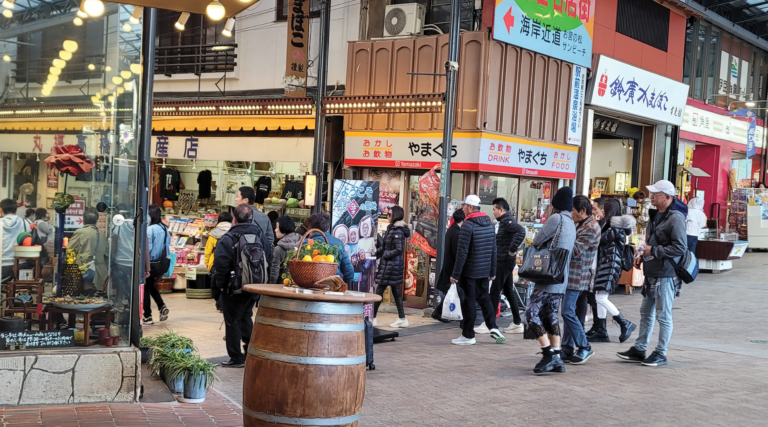
Story and pictures by Jason Rupp and Carla Marie Rupp
The yen was at its lowest value so it was an excellent time for us to visit Japan. We decided on six nights but didn’t book any accommodation – no plans at all. We figured there would be an adventure awaiting us. So, at the Tokyo airport, we debated how to spend the six days before our next flight to Bangkok. We had experienced the big, busy, exciting city of Tokyo on previous trips and were ready for something new and much slower-paced. While still at the airport Jason chatted online to his Japanese friend Ken who gave the best recommendation on where to go to relax.
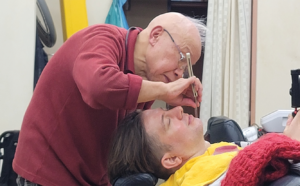
Atami – a seaside city known for hot springs and sushi, just 90 minutes away from Tokyo. We longed for the perfect chill Japanese experience – soaking in the “onsen” hot springs, and were pleased to learn that Atami has spas all over town. Between meals and soaking, we also hoped Jason would find new travel and pampering experiences for videos to film for his YouTube channel: Jason Rupp. So we agreed going to Atami would be a win-win. Jason booked us into one of the most centrally-located guest houses and we set out on a train from Haneda airport direct to Atami. Japan’s trains are so well-connected, we didn’t even have to go into downtown Tokyo first. Then after arriving at the Atami railway station, we began the 15-minute walk, pulling our luggage to the lodging. The walk was pretty exhausting since Atami is very hilly and any walk around this big town is a workout!
We had chosen Guest House Maruya because of its perfect location in the center of town. The staff welcomed us, checked us in, and brought us to a really cozy private bunk bedroom. We could handle it! It was okay – especially for the $45/night we paid. In fact we were lucky to have a private room because many of the budget lodgings here are “capsule rooms” that appeal to Japanese young adults. Exploring is best done walking around, and we did plenty of that – up and down the hills! For Jason’s YouTube channel, we also found several YouTube video experiences. One was with an 85-year-old barber who gave Jason an amazing shave and haircut.
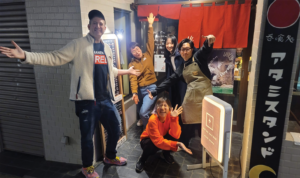
Our base was in the most happening part of town – the Atami Ginza Shopping District – full of cute bars and trendy little cafes. We went into many of them experiencing a variety of Japanese dining experiences, including splurging on big sushi meals. Some of the quirky bars were fun, too. For example, in a nightlife complex, we found a tiny muscleman bar called Macho Man. In the bar there was only space for five or six people max. A huge muscle man welcomes us by smiling, says hello, and then instantly becomes the bartender. Jason loved it since he has been known to enjoy the entertainment of pro wrestling. Atami Stand Bistro was tops on our dining list. We liked the food so much that we became friendly with owner Masahiro Kino and chef Kouta Hibino, their philosophy is to make everything tasty. We still dream about the way they make their vegetables so delicious: shitake mushrooms, asparagus, eggplant, zucchini, avocado and lotus, and curry white radish salad.
At Stand, we met volunteers who had come to Atami to work on projects repairing damaged old houses. These kind and caring people come here to repair buildings in the area where there has been a landslide. We also met an interior designer, Yatsu-san, who makes tables, chairs and bookcases. The town is full of creative people, including operators of art galleries and crafts shops. The owner of our guesthouse is amongst those who encourage new businesses to open here. They want the town to become lively again. Apparently, Atami was forgotten for a while but is now coming back into style big time.
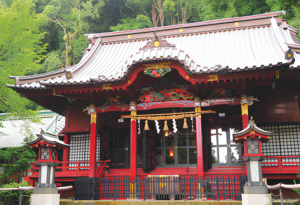
Atami means “hot ocean,” and refers to the onsen hot springs and the mineral water here which is said to be full of health for all ages. We often remarked how healthy the locals appeared, and younger than the ages they said they were. Also signs of spas were all over the place with steaming pipes, like a maze going throughout the town. Many residents even have their own onsen in the backyards and apartment buildings. However, for visitors, some of the best places to experience onsen are Otsuki Hotel Wafukan, Myoraku-Yu, and Oedo Onsen Monogatari Atami.By the beach, we found: Atami Seaside Spa and Hotel where you just pay a small fee (equal to $5 USD). We went to this spa several times to enjoy the soaking. Atami is in the far eastern corner of Shizuoka Prefecture, on the northern end of the Izu Peninsula. Since the 8th century AD, it has been the favorite town near Tokyo, centered on its soothing hot springs. The population of Atami is around 40,000 residents and this coastal resort used to be known as a Japanese honeymoon resort. Even dignitaries used to visit. Now regular Tokyoites like to come here, particularly on the weekend. We saw many of these happy people having a good time but it was nice to also see Atami during the week without all the weekend visitors taking their selfies.
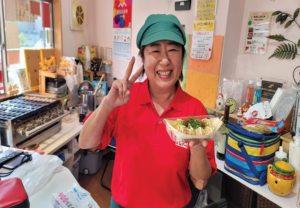
Symbols of Atami are the common gull bird, the ume flower, and the sakura tree. You can see over 200 sakura trees planted in the garden of The Atami Castle, which also has several museums inside. including a Samurai cultural museum. there. We found this castle one of the many scenic sights by day and evening; magnificent with the night skyline. Other top Atami sights include the Izusan Jinja Shrine (an ancient Shinto shrine), Atami Plum Garden, the Atami Sun Beach, the Peace Pagoda (built in 1961), and the MOA Museum of Art, housing the art collection of eccentric multi-millionaire Mokichi Okada.
What we liked so much about Atami is that it’s walkable, fun and relaxing. Fairly small (61.78 square miles) it sits on the steep slopes of a partially submerged volcanic caldera at the edge of beautiful Sagami Bay. If you go to a high point, you can see the landscape of Mt. Fuji. During walks, you can also come across video gambling arcades and food stalls. We liked trying local dishes and we found a Japanese food truck serving a delicious snack called Takoyaki – a grilled squid and seaweed ball. We ate as we stopped on a bench near a canal to listen to a jazz festival going on.

We loved that Atami is a beach city, like Pattaya and has nightlife, but much more toned-down. You have to seek out the evening party scene on the little side streets. Strolling along the promenade or sitting on Sun Beach in town, with its nice breeze, was a pleasant experience at any time of day. We had a wonderful time looking around the hilly little town. It is certainly a Japanese place worth visiting, whether you are a backpacker, a couple, solo or part of a family. While many people only spend a day or two in Atami, we found it relaxing and easy to spend close to a week.
There are very few expats or foreigners here, so you can get a real Japanese experience where you’re able to almost feel like you’re a local.Less than two hours from Tokyo. You can drive a car, take a bus or train. The three train operators are Japan Railway Shinkansen, JR EAST (East Japan Railway Company), and Japan Railway Limited Express. As American tourists, we cherished this Atami, Japan trip for our stopover to Thailand! Atami is a local treasure not many foreigners know about. We loved having made this discovery.
Jason Rupp and Carla Marie Rupp are freelance travel journalists who enjoy exploring and having adventures and experiences. Their YouTube Channel is called Jason Rupp: Travel & Pamper and they enjoy writing about their trips for Discover Pattaya luxury magazine.
